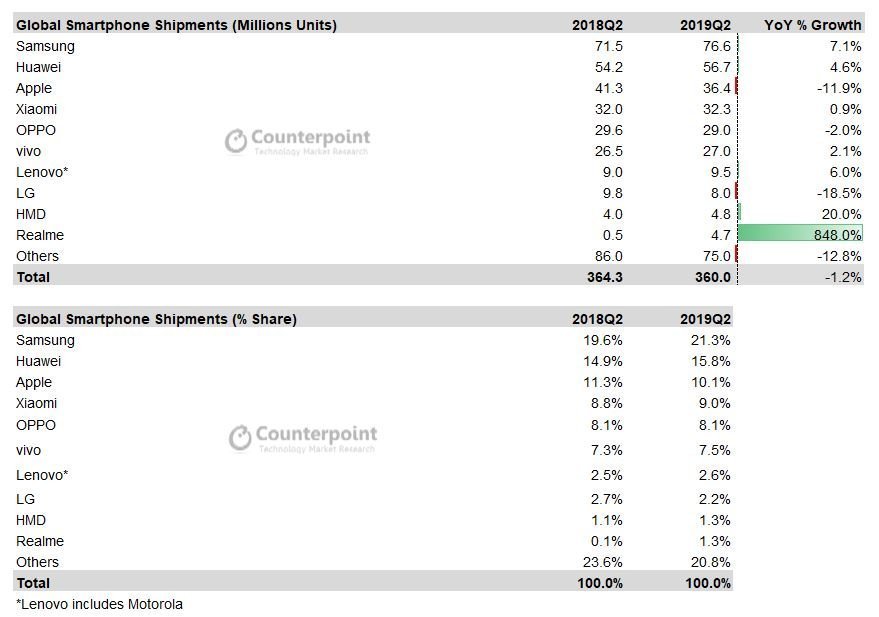• Overall smartphone shipment declined 1% in Q2 2019, making it the seventh consecutive quarter of declining shipments.
• Huawei’s shipment ban hurt it in overseas markets, but domestic market growth offset some of the pain; Realme entered the top 10 brands for the first time.
The combined global smartphone market share of Chinese majors Huawei, OPPO, Vivo, Xiaomi, and Realme (HOVXR) reached 42% in Q2 2019, the highest it has ever been. This was even as global smartphone shipments fell 1.2% year-on-year (YoY) to 360 million units during Q2 2019, making it the seventh consecutive quarter of decline.
Commenting on the record market share for HOVXR, Varun Mishra, Research Analyst at Counterpoint Research noted, “Heavy marketing, faster portfolio refresh, high spec devices at aggressive prices, and multi-channel presence are some of the key reasons why Chinese brands fared better than the local and global OEMs. These brands have been aggressively expanding outside China and achieving growth offsetting the saturation in their home market. Their strategies and product portfolios are more aligned to the local needs and preferences, which is one of their key strengths.”
Exhibit: Smartphone Shipment Market Share 2019 Q2
Source: Counterpoint Research : Quarterly Market Monitor Q2 2019
The smartphone market slowdown is mainly due to China, which has continued to decline for two years now. China alone accounts for over one-fourth of the global smartphone shipments and declined 9% YoY during the quarter. The heightened US-China trade war during the quarter has further escalated the uncertainties of the smartphone market. India remains a key growth market as the shipments set a second-quarter record,
Commenting on the trade war Tarun Pathak, Associate Director at Counterpoint Research, said “The US-China trade war escalated with Huawei added in the entity list in May. Despite the ban, Huawei was able to register a 4.6% growth during the quarter, capturing a 16% market share. The effect of the ban did not translate into falling shipments during this quarter, which will not be the case in the future. In the coming quarters, Huawei is likely to be aggressive in its home market and register some growth there, but it will not be enough to offset for the decline in its overseas shipments. This will further lead to the decline of the overall smartphone market in 2019. However, the gap created in the market by Huawei gives a window of opportunity to other OEMs, especially Samsung, to leverage.”
A portion of the decline in 2019 is likely to be compensated by the adoption of 5G.
Commenting on 5G, Varun Mishra, added “We expect that 5G will have a faster rollout than 4G LTE. Unlike 4G, which was split between FDD-LTE and TD-LTE, 5G has a universal standard, which will make the ramp-up faster. We expect sales of 5G devices to be over 20 million in 2019. Network expansion of carriers, subsidies, and more OEMs committing to early 5G device launches than during the early 4G era Since these devices are expected to be limited to the premium segment in 2019, the adoption will also drive the market average selling price (ASP). Consumers are also expecting to pay higher for the 5G smartphone than what they paid for the 4G device.”
Even though shipments continued to decline, the market ASP is likely to increase, which will drive revenue for the industry. Adoption of 5G in mature economies and the shift from entry-level phones to mid-segment phones in emerging economies will drive up ASPs.
Key Takeaways :
- Samsung grew 7.1% YoY, capturing over one-fifth of the global smartphone market share. The OEM has completely overhauled its product portfolio in 2019 with its A and M series targeting the sub $300 price segment aggressively. The flagship S series, in which Samsung launched three devices instead of the usual two, covering wider price points also continue to do well. Samsung was also one of the first OEMs to launch a 5G device – S10 5G, which remains popular in the 5G adopting
- Huawei grew 4.6% YoY, but the US trade ban will its growth momentum, especially in the overseas market. The effect in Q2 2019 was not severe as the order came late into the quarter. The real effect of trade sanction will be in Q3 2019. Shipments in overseas markets are estimated to register a steep decline.
- Apple iPhone shipments fell 11%, and iPhone revenues fell 12% year-on-year. Despite this decline, iPhone sales trends are improving. Apple’s buyback programs and other marketing are dampening growing holding periods. However, the lack of 5G over upcoming quarters may again increase holding periods.
- Realme entered the top 10 OEMs globally for the first time. It took Realme only a year to achieve this feat. This is one of the fastest ramp-ups. Strong performance in India and expansion overseas drove its growth. This was also the third consecutive quarter that Realme sold within top 5 brands in India.
- This was the third consecutive quarter of a decline in Apple iPhone shipments. To ramp up sales, Apple implemented price cuts for the iPhone XR in India and China markets. Amid the slowdown in China and likely launch of 5G capable iPhone in 2020, Apple will have to concentrate its efforts on emerging markets.
- The market further consolidated with the top 10 brands’ market share increasing to 79% from 76% a year ago.
- BBK Group is now the second-largest smartphone manufacturer globally.























